Strategic Analysis of Asda: Applying Porter's Five Forces and SWOT
VerifiedAdded on 2020/01/07
|13
|3845
|184
Report
AI Summary
This report provides a comprehensive strategic analysis of Asda, a major British supermarket chain. It begins with an introduction to strategic management and then delves into an examination of Porter's Five Forces model, critically analyzing its relevance and applicability in today's dynamic market environment. The report then conducts a detailed company analysis of Asda, employing both SWOT and PEST analyses to assess its internal strengths and weaknesses, as well as external opportunities and threats. The SWOT analysis evaluates Asda's strengths (e.g., brand reputation, IT capabilities), weaknesses (e.g., lack of loyalty cards), opportunities (e.g., online shopping growth), and threats (e.g., competition from discounters). The PEST analysis examines the political, economic, socio-cultural, and technological factors impacting Asda's operations. Finally, the report considers the practical application of the theories discussed, evaluating how Porter's model informs Asda's strategic decisions and overall competitive position. The analysis highlights the importance of adapting to changing market conditions and incorporating new business models. The report also discusses the limitations of Porter's model and its applicability to complex, interconnected industries.
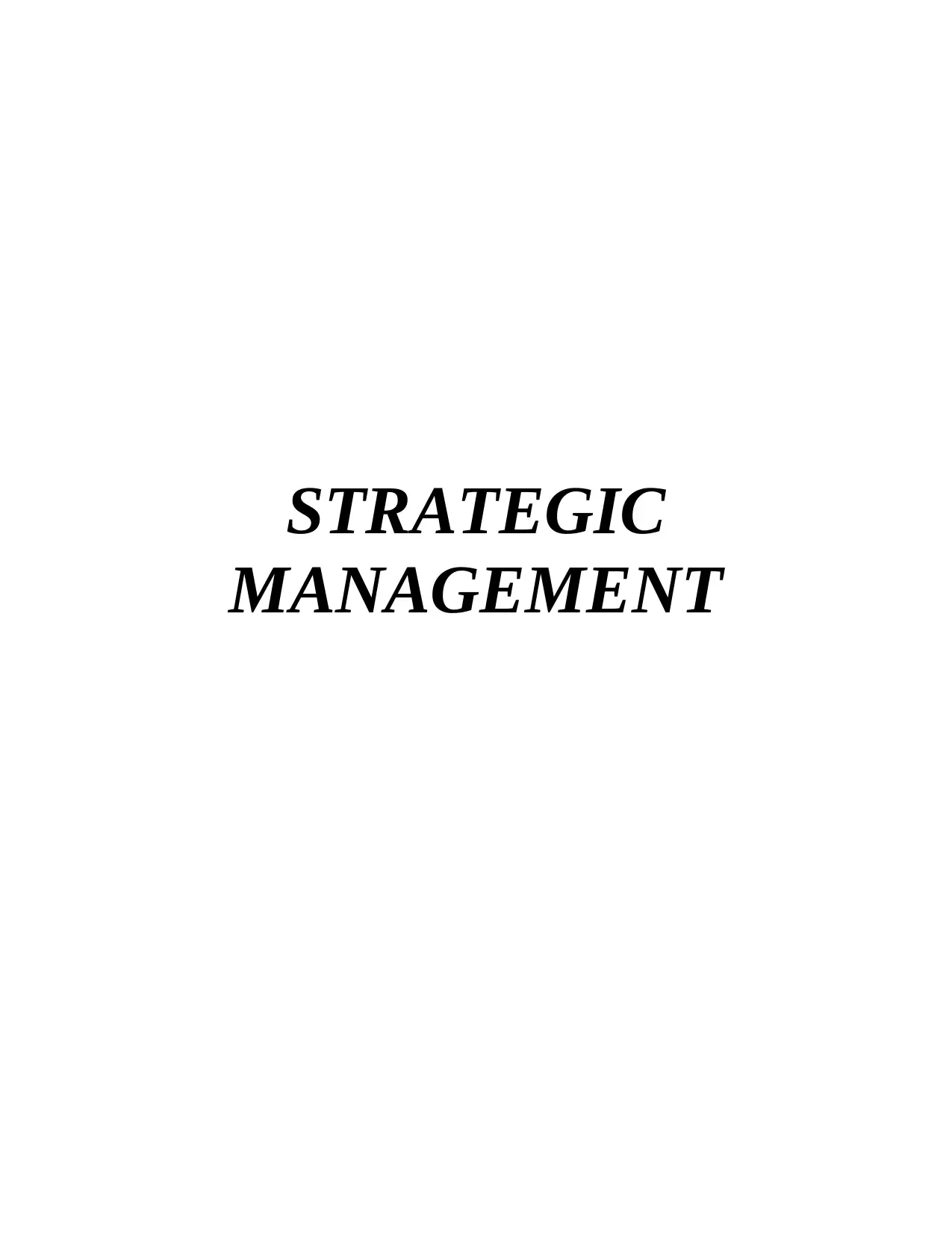
STRATEGIC
MANAGEMENT
MANAGEMENT
Paraphrase This Document
Need a fresh take? Get an instant paraphrase of this document with our AI Paraphraser
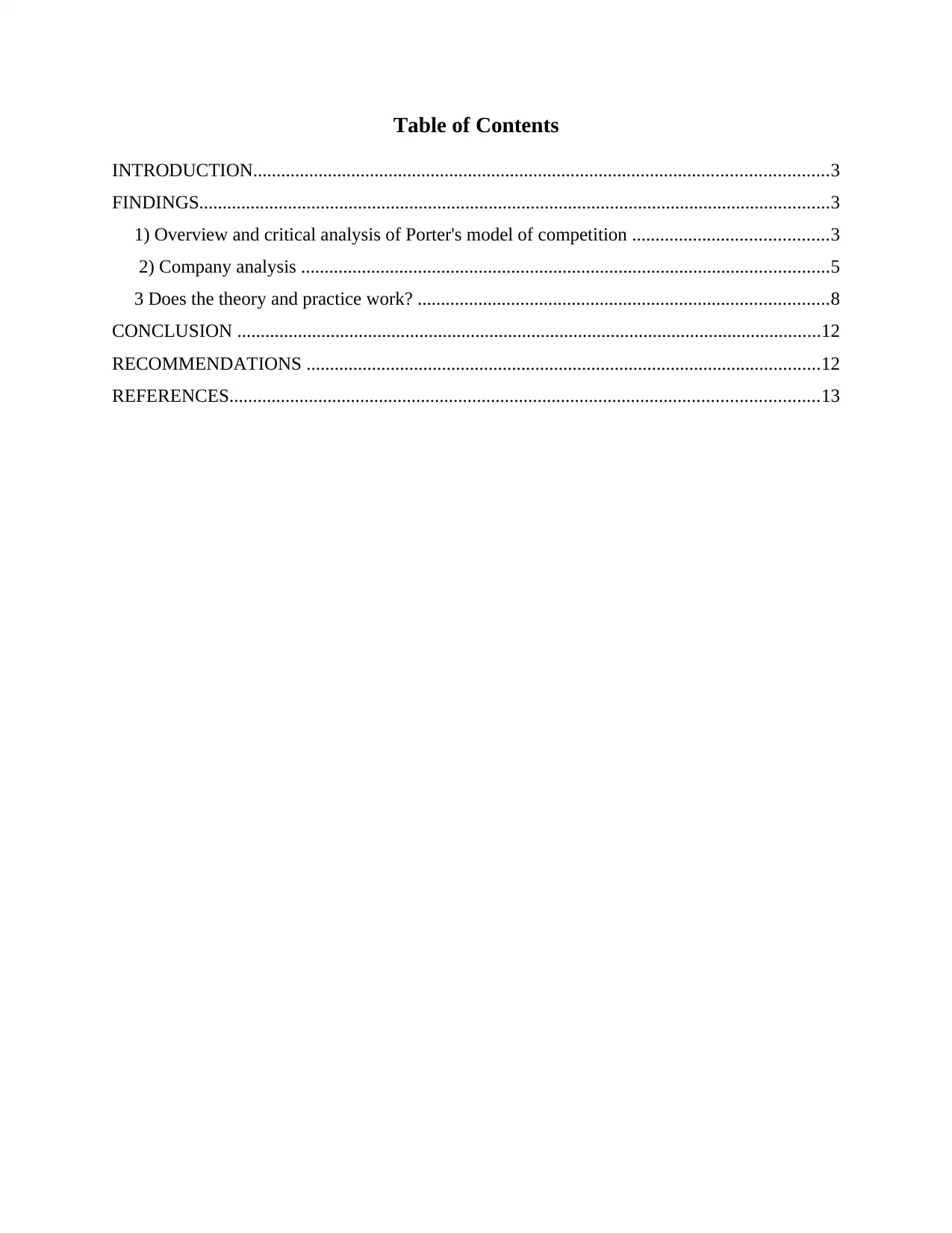
Table of Contents
INTRODUCTION...........................................................................................................................3
FINDINGS.......................................................................................................................................3
1) Overview and critical analysis of Porter's model of competition ..........................................3
2) Company analysis .................................................................................................................5
3 Does the theory and practice work? ........................................................................................8
CONCLUSION .............................................................................................................................12
RECOMMENDATIONS ..............................................................................................................12
REFERENCES..............................................................................................................................13
INTRODUCTION...........................................................................................................................3
FINDINGS.......................................................................................................................................3
1) Overview and critical analysis of Porter's model of competition ..........................................3
2) Company analysis .................................................................................................................5
3 Does the theory and practice work? ........................................................................................8
CONCLUSION .............................................................................................................................12
RECOMMENDATIONS ..............................................................................................................12
REFERENCES..............................................................................................................................13
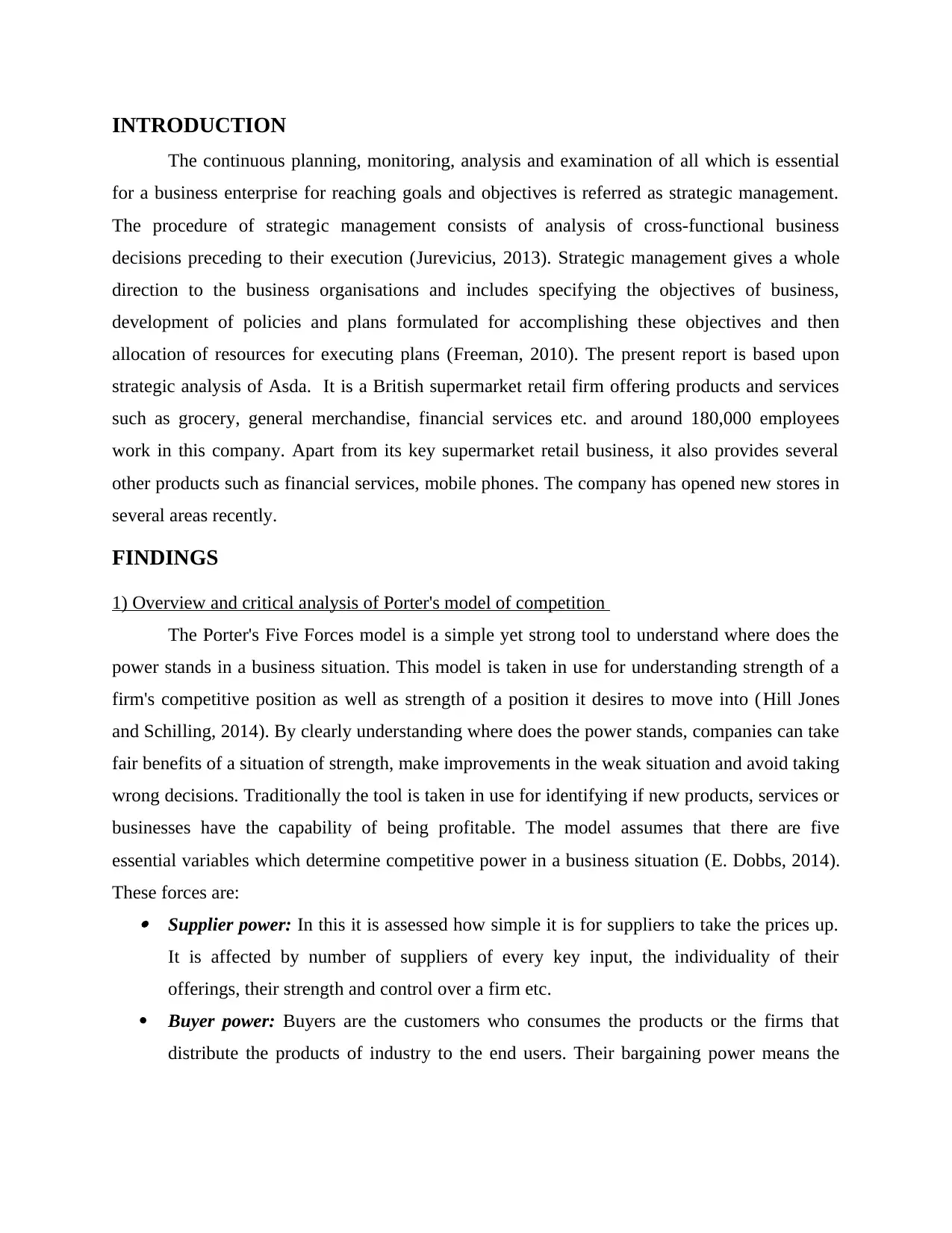
INTRODUCTION
The continuous planning, monitoring, analysis and examination of all which is essential
for a business enterprise for reaching goals and objectives is referred as strategic management.
The procedure of strategic management consists of analysis of cross-functional business
decisions preceding to their execution (Jurevicius, 2013). Strategic management gives a whole
direction to the business organisations and includes specifying the objectives of business,
development of policies and plans formulated for accomplishing these objectives and then
allocation of resources for executing plans (Freeman, 2010). The present report is based upon
strategic analysis of Asda. It is a British supermarket retail firm offering products and services
such as grocery, general merchandise, financial services etc. and around 180,000 employees
work in this company. Apart from its key supermarket retail business, it also provides several
other products such as financial services, mobile phones. The company has opened new stores in
several areas recently.
FINDINGS
1) Overview and critical analysis of Porter's model of competition
The Porter's Five Forces model is a simple yet strong tool to understand where does the
power stands in a business situation. This model is taken in use for understanding strength of a
firm's competitive position as well as strength of a position it desires to move into ( Hill Jones
and Schilling, 2014). By clearly understanding where does the power stands, companies can take
fair benefits of a situation of strength, make improvements in the weak situation and avoid taking
wrong decisions. Traditionally the tool is taken in use for identifying if new products, services or
businesses have the capability of being profitable. The model assumes that there are five
essential variables which determine competitive power in a business situation (E. Dobbs, 2014).
These forces are: Supplier power: In this it is assessed how simple it is for suppliers to take the prices up.
It is affected by number of suppliers of every key input, the individuality of their
offerings, their strength and control over a firm etc.
Buyer power: Buyers are the customers who consumes the products or the firms that
distribute the products of industry to the end users. Their bargaining power means the
The continuous planning, monitoring, analysis and examination of all which is essential
for a business enterprise for reaching goals and objectives is referred as strategic management.
The procedure of strategic management consists of analysis of cross-functional business
decisions preceding to their execution (Jurevicius, 2013). Strategic management gives a whole
direction to the business organisations and includes specifying the objectives of business,
development of policies and plans formulated for accomplishing these objectives and then
allocation of resources for executing plans (Freeman, 2010). The present report is based upon
strategic analysis of Asda. It is a British supermarket retail firm offering products and services
such as grocery, general merchandise, financial services etc. and around 180,000 employees
work in this company. Apart from its key supermarket retail business, it also provides several
other products such as financial services, mobile phones. The company has opened new stores in
several areas recently.
FINDINGS
1) Overview and critical analysis of Porter's model of competition
The Porter's Five Forces model is a simple yet strong tool to understand where does the
power stands in a business situation. This model is taken in use for understanding strength of a
firm's competitive position as well as strength of a position it desires to move into ( Hill Jones
and Schilling, 2014). By clearly understanding where does the power stands, companies can take
fair benefits of a situation of strength, make improvements in the weak situation and avoid taking
wrong decisions. Traditionally the tool is taken in use for identifying if new products, services or
businesses have the capability of being profitable. The model assumes that there are five
essential variables which determine competitive power in a business situation (E. Dobbs, 2014).
These forces are: Supplier power: In this it is assessed how simple it is for suppliers to take the prices up.
It is affected by number of suppliers of every key input, the individuality of their
offerings, their strength and control over a firm etc.
Buyer power: Buyers are the customers who consumes the products or the firms that
distribute the products of industry to the end users. Their bargaining power means the
⊘ This is a preview!⊘
Do you want full access?
Subscribe today to unlock all pages.

Trusted by 1+ million students worldwide
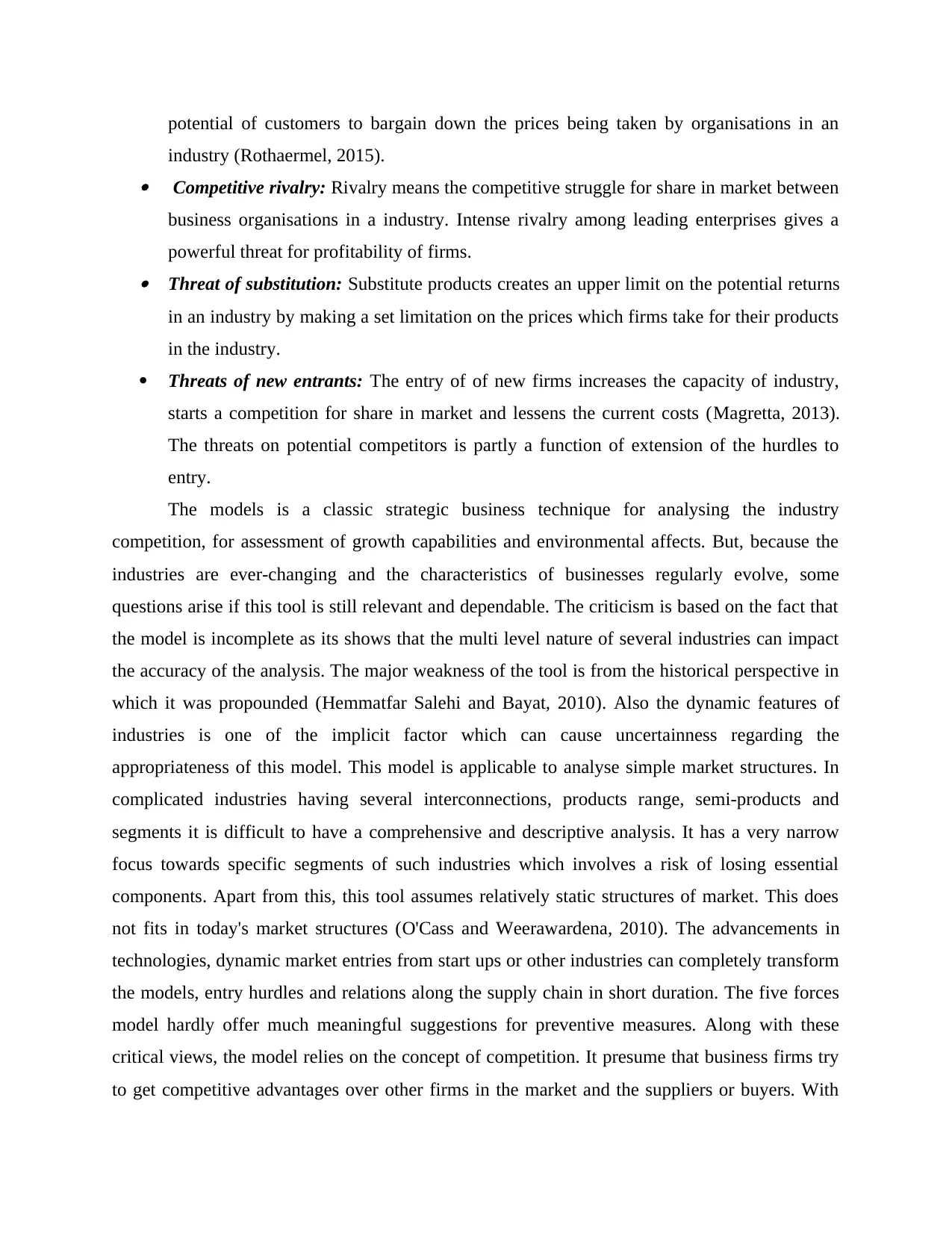
potential of customers to bargain down the prices being taken by organisations in an
industry (Rothaermel, 2015). Competitive rivalry: Rivalry means the competitive struggle for share in market between
business organisations in a industry. Intense rivalry among leading enterprises gives a
powerful threat for profitability of firms. Threat of substitution: Substitute products creates an upper limit on the potential returns
in an industry by making a set limitation on the prices which firms take for their products
in the industry.
Threats of new entrants: The entry of of new firms increases the capacity of industry,
starts a competition for share in market and lessens the current costs (Magretta, 2013).
The threats on potential competitors is partly a function of extension of the hurdles to
entry.
The models is a classic strategic business technique for analysing the industry
competition, for assessment of growth capabilities and environmental affects. But, because the
industries are ever-changing and the characteristics of businesses regularly evolve, some
questions arise if this tool is still relevant and dependable. The criticism is based on the fact that
the model is incomplete as its shows that the multi level nature of several industries can impact
the accuracy of the analysis. The major weakness of the tool is from the historical perspective in
which it was propounded (Hemmatfar Salehi and Bayat, 2010). Also the dynamic features of
industries is one of the implicit factor which can cause uncertainness regarding the
appropriateness of this model. This model is applicable to analyse simple market structures. In
complicated industries having several interconnections, products range, semi-products and
segments it is difficult to have a comprehensive and descriptive analysis. It has a very narrow
focus towards specific segments of such industries which involves a risk of losing essential
components. Apart from this, this tool assumes relatively static structures of market. This does
not fits in today's market structures (O'Cass and Weerawardena, 2010). The advancements in
technologies, dynamic market entries from start ups or other industries can completely transform
the models, entry hurdles and relations along the supply chain in short duration. The five forces
model hardly offer much meaningful suggestions for preventive measures. Along with these
critical views, the model relies on the concept of competition. It presume that business firms try
to get competitive advantages over other firms in the market and the suppliers or buyers. With
industry (Rothaermel, 2015). Competitive rivalry: Rivalry means the competitive struggle for share in market between
business organisations in a industry. Intense rivalry among leading enterprises gives a
powerful threat for profitability of firms. Threat of substitution: Substitute products creates an upper limit on the potential returns
in an industry by making a set limitation on the prices which firms take for their products
in the industry.
Threats of new entrants: The entry of of new firms increases the capacity of industry,
starts a competition for share in market and lessens the current costs (Magretta, 2013).
The threats on potential competitors is partly a function of extension of the hurdles to
entry.
The models is a classic strategic business technique for analysing the industry
competition, for assessment of growth capabilities and environmental affects. But, because the
industries are ever-changing and the characteristics of businesses regularly evolve, some
questions arise if this tool is still relevant and dependable. The criticism is based on the fact that
the model is incomplete as its shows that the multi level nature of several industries can impact
the accuracy of the analysis. The major weakness of the tool is from the historical perspective in
which it was propounded (Hemmatfar Salehi and Bayat, 2010). Also the dynamic features of
industries is one of the implicit factor which can cause uncertainness regarding the
appropriateness of this model. This model is applicable to analyse simple market structures. In
complicated industries having several interconnections, products range, semi-products and
segments it is difficult to have a comprehensive and descriptive analysis. It has a very narrow
focus towards specific segments of such industries which involves a risk of losing essential
components. Apart from this, this tool assumes relatively static structures of market. This does
not fits in today's market structures (O'Cass and Weerawardena, 2010). The advancements in
technologies, dynamic market entries from start ups or other industries can completely transform
the models, entry hurdles and relations along the supply chain in short duration. The five forces
model hardly offer much meaningful suggestions for preventive measures. Along with these
critical views, the model relies on the concept of competition. It presume that business firms try
to get competitive advantages over other firms in the market and the suppliers or buyers. With
Paraphrase This Document
Need a fresh take? Get an instant paraphrase of this document with our AI Paraphraser
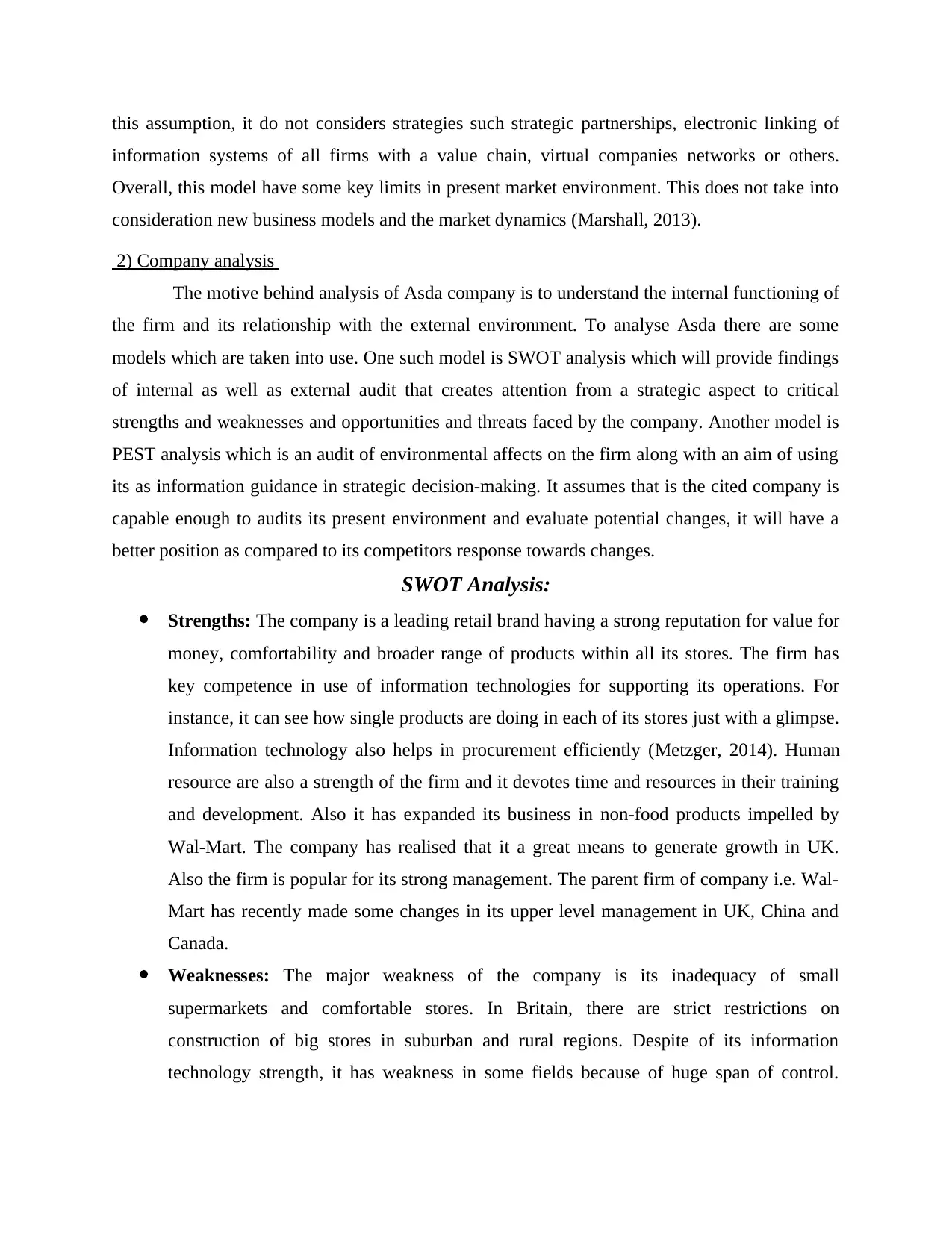
this assumption, it do not considers strategies such strategic partnerships, electronic linking of
information systems of all firms with a value chain, virtual companies networks or others.
Overall, this model have some key limits in present market environment. This does not take into
consideration new business models and the market dynamics (Marshall, 2013).
2) Company analysis
The motive behind analysis of Asda company is to understand the internal functioning of
the firm and its relationship with the external environment. To analyse Asda there are some
models which are taken into use. One such model is SWOT analysis which will provide findings
of internal as well as external audit that creates attention from a strategic aspect to critical
strengths and weaknesses and opportunities and threats faced by the company. Another model is
PEST analysis which is an audit of environmental affects on the firm along with an aim of using
its as information guidance in strategic decision-making. It assumes that is the cited company is
capable enough to audits its present environment and evaluate potential changes, it will have a
better position as compared to its competitors response towards changes.
SWOT Analysis:
Strengths: The company is a leading retail brand having a strong reputation for value for
money, comfortability and broader range of products within all its stores. The firm has
key competence in use of information technologies for supporting its operations. For
instance, it can see how single products are doing in each of its stores just with a glimpse.
Information technology also helps in procurement efficiently (Metzger, 2014). Human
resource are also a strength of the firm and it devotes time and resources in their training
and development. Also it has expanded its business in non-food products impelled by
Wal-Mart. The company has realised that it a great means to generate growth in UK.
Also the firm is popular for its strong management. The parent firm of company i.e. Wal-
Mart has recently made some changes in its upper level management in UK, China and
Canada.
Weaknesses: The major weakness of the company is its inadequacy of small
supermarkets and comfortable stores. In Britain, there are strict restrictions on
construction of big stores in suburban and rural regions. Despite of its information
technology strength, it has weakness in some fields because of huge span of control.
information systems of all firms with a value chain, virtual companies networks or others.
Overall, this model have some key limits in present market environment. This does not take into
consideration new business models and the market dynamics (Marshall, 2013).
2) Company analysis
The motive behind analysis of Asda company is to understand the internal functioning of
the firm and its relationship with the external environment. To analyse Asda there are some
models which are taken into use. One such model is SWOT analysis which will provide findings
of internal as well as external audit that creates attention from a strategic aspect to critical
strengths and weaknesses and opportunities and threats faced by the company. Another model is
PEST analysis which is an audit of environmental affects on the firm along with an aim of using
its as information guidance in strategic decision-making. It assumes that is the cited company is
capable enough to audits its present environment and evaluate potential changes, it will have a
better position as compared to its competitors response towards changes.
SWOT Analysis:
Strengths: The company is a leading retail brand having a strong reputation for value for
money, comfortability and broader range of products within all its stores. The firm has
key competence in use of information technologies for supporting its operations. For
instance, it can see how single products are doing in each of its stores just with a glimpse.
Information technology also helps in procurement efficiently (Metzger, 2014). Human
resource are also a strength of the firm and it devotes time and resources in their training
and development. Also it has expanded its business in non-food products impelled by
Wal-Mart. The company has realised that it a great means to generate growth in UK.
Also the firm is popular for its strong management. The parent firm of company i.e. Wal-
Mart has recently made some changes in its upper level management in UK, China and
Canada.
Weaknesses: The major weakness of the company is its inadequacy of small
supermarkets and comfortable stores. In Britain, there are strict restrictions on
construction of big stores in suburban and rural regions. Despite of its information
technology strength, it has weakness in some fields because of huge span of control.
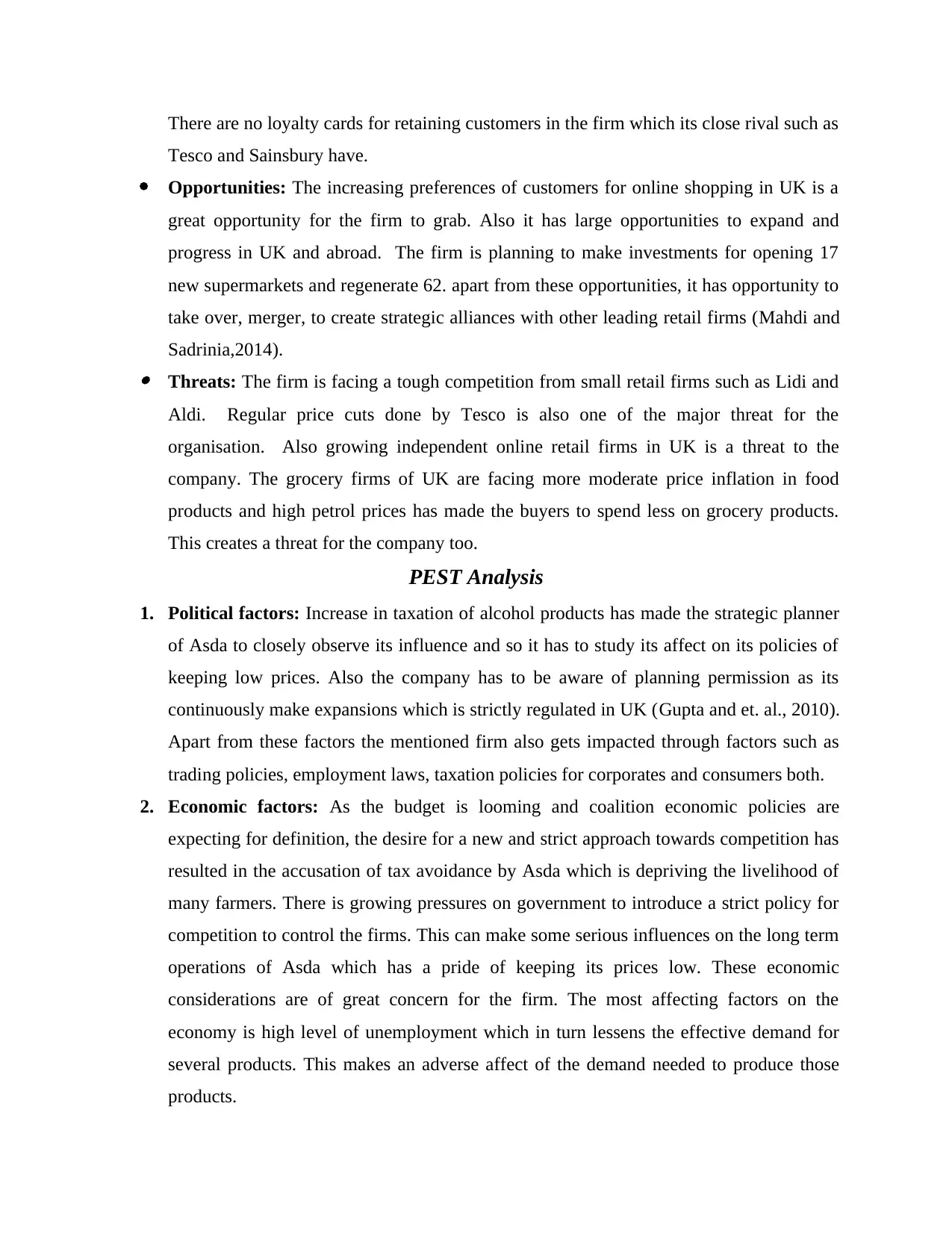
There are no loyalty cards for retaining customers in the firm which its close rival such as
Tesco and Sainsbury have.
Opportunities: The increasing preferences of customers for online shopping in UK is a
great opportunity for the firm to grab. Also it has large opportunities to expand and
progress in UK and abroad. The firm is planning to make investments for opening 17
new supermarkets and regenerate 62. apart from these opportunities, it has opportunity to
take over, merger, to create strategic alliances with other leading retail firms (Mahdi and
Sadrinia,2014). Threats: The firm is facing a tough competition from small retail firms such as Lidi and
Aldi. Regular price cuts done by Tesco is also one of the major threat for the
organisation. Also growing independent online retail firms in UK is a threat to the
company. The grocery firms of UK are facing more moderate price inflation in food
products and high petrol prices has made the buyers to spend less on grocery products.
This creates a threat for the company too.
PEST Analysis
1. Political factors: Increase in taxation of alcohol products has made the strategic planner
of Asda to closely observe its influence and so it has to study its affect on its policies of
keeping low prices. Also the company has to be aware of planning permission as its
continuously make expansions which is strictly regulated in UK (Gupta and et. al., 2010).
Apart from these factors the mentioned firm also gets impacted through factors such as
trading policies, employment laws, taxation policies for corporates and consumers both.
2. Economic factors: As the budget is looming and coalition economic policies are
expecting for definition, the desire for a new and strict approach towards competition has
resulted in the accusation of tax avoidance by Asda which is depriving the livelihood of
many farmers. There is growing pressures on government to introduce a strict policy for
competition to control the firms. This can make some serious influences on the long term
operations of Asda which has a pride of keeping its prices low. These economic
considerations are of great concern for the firm. The most affecting factors on the
economy is high level of unemployment which in turn lessens the effective demand for
several products. This makes an adverse affect of the demand needed to produce those
products.
Tesco and Sainsbury have.
Opportunities: The increasing preferences of customers for online shopping in UK is a
great opportunity for the firm to grab. Also it has large opportunities to expand and
progress in UK and abroad. The firm is planning to make investments for opening 17
new supermarkets and regenerate 62. apart from these opportunities, it has opportunity to
take over, merger, to create strategic alliances with other leading retail firms (Mahdi and
Sadrinia,2014). Threats: The firm is facing a tough competition from small retail firms such as Lidi and
Aldi. Regular price cuts done by Tesco is also one of the major threat for the
organisation. Also growing independent online retail firms in UK is a threat to the
company. The grocery firms of UK are facing more moderate price inflation in food
products and high petrol prices has made the buyers to spend less on grocery products.
This creates a threat for the company too.
PEST Analysis
1. Political factors: Increase in taxation of alcohol products has made the strategic planner
of Asda to closely observe its influence and so it has to study its affect on its policies of
keeping low prices. Also the company has to be aware of planning permission as its
continuously make expansions which is strictly regulated in UK (Gupta and et. al., 2010).
Apart from these factors the mentioned firm also gets impacted through factors such as
trading policies, employment laws, taxation policies for corporates and consumers both.
2. Economic factors: As the budget is looming and coalition economic policies are
expecting for definition, the desire for a new and strict approach towards competition has
resulted in the accusation of tax avoidance by Asda which is depriving the livelihood of
many farmers. There is growing pressures on government to introduce a strict policy for
competition to control the firms. This can make some serious influences on the long term
operations of Asda which has a pride of keeping its prices low. These economic
considerations are of great concern for the firm. The most affecting factors on the
economy is high level of unemployment which in turn lessens the effective demand for
several products. This makes an adverse affect of the demand needed to produce those
products.
⊘ This is a preview!⊘
Do you want full access?
Subscribe today to unlock all pages.

Trusted by 1+ million students worldwide
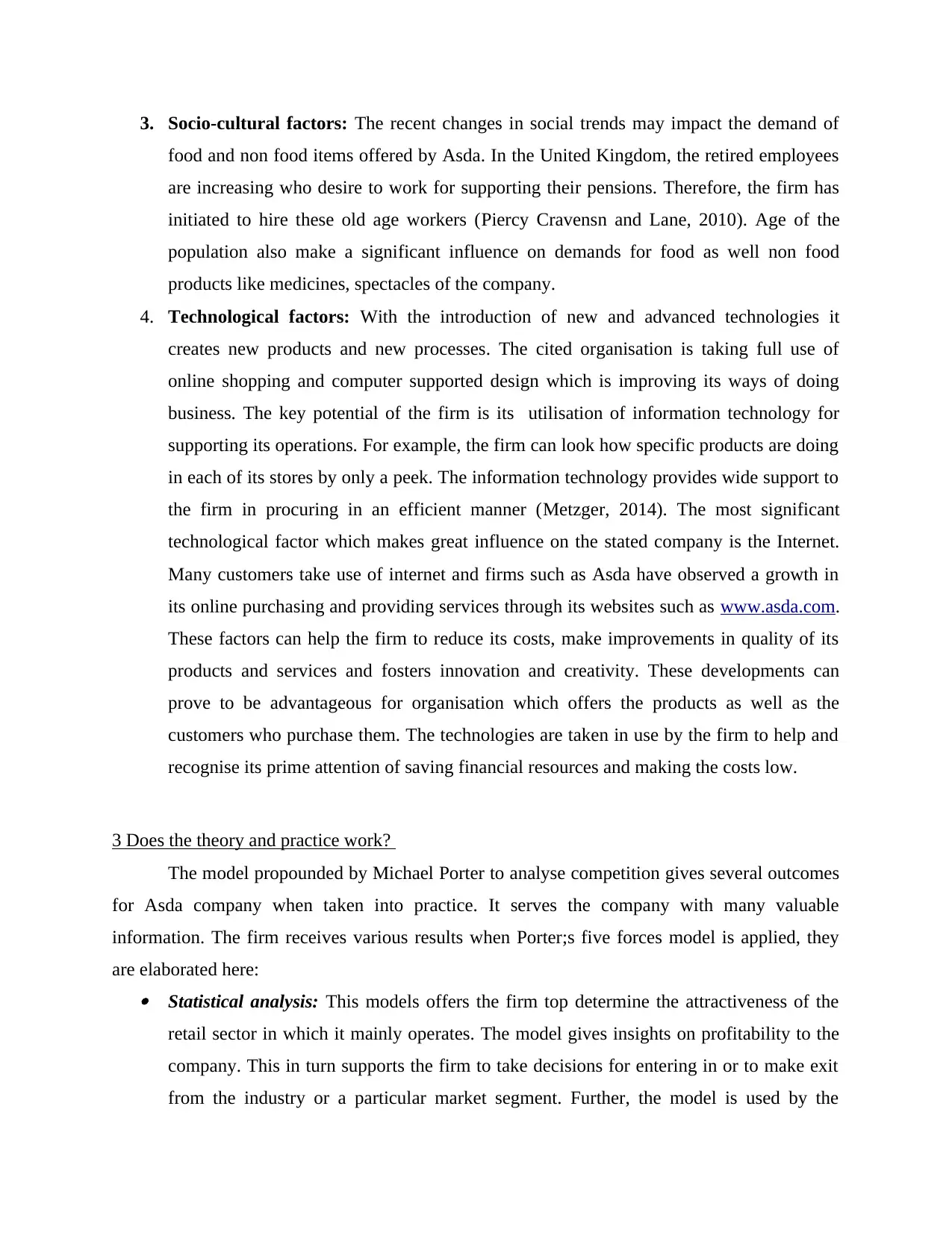
3. Socio-cultural factors: The recent changes in social trends may impact the demand of
food and non food items offered by Asda. In the United Kingdom, the retired employees
are increasing who desire to work for supporting their pensions. Therefore, the firm has
initiated to hire these old age workers (Piercy Cravensn and Lane, 2010). Age of the
population also make a significant influence on demands for food as well non food
products like medicines, spectacles of the company.
4. Technological factors: With the introduction of new and advanced technologies it
creates new products and new processes. The cited organisation is taking full use of
online shopping and computer supported design which is improving its ways of doing
business. The key potential of the firm is its utilisation of information technology for
supporting its operations. For example, the firm can look how specific products are doing
in each of its stores by only a peek. The information technology provides wide support to
the firm in procuring in an efficient manner (Metzger, 2014). The most significant
technological factor which makes great influence on the stated company is the Internet.
Many customers take use of internet and firms such as Asda have observed a growth in
its online purchasing and providing services through its websites such as www.asda.com.
These factors can help the firm to reduce its costs, make improvements in quality of its
products and services and fosters innovation and creativity. These developments can
prove to be advantageous for organisation which offers the products as well as the
customers who purchase them. The technologies are taken in use by the firm to help and
recognise its prime attention of saving financial resources and making the costs low.
3 Does the theory and practice work?
The model propounded by Michael Porter to analyse competition gives several outcomes
for Asda company when taken into practice. It serves the company with many valuable
information. The firm receives various results when Porter;s five forces model is applied, they
are elaborated here: Statistical analysis: This models offers the firm top determine the attractiveness of the
retail sector in which it mainly operates. The model gives insights on profitability to the
company. This in turn supports the firm to take decisions for entering in or to make exit
from the industry or a particular market segment. Further, the model is used by the
food and non food items offered by Asda. In the United Kingdom, the retired employees
are increasing who desire to work for supporting their pensions. Therefore, the firm has
initiated to hire these old age workers (Piercy Cravensn and Lane, 2010). Age of the
population also make a significant influence on demands for food as well non food
products like medicines, spectacles of the company.
4. Technological factors: With the introduction of new and advanced technologies it
creates new products and new processes. The cited organisation is taking full use of
online shopping and computer supported design which is improving its ways of doing
business. The key potential of the firm is its utilisation of information technology for
supporting its operations. For example, the firm can look how specific products are doing
in each of its stores by only a peek. The information technology provides wide support to
the firm in procuring in an efficient manner (Metzger, 2014). The most significant
technological factor which makes great influence on the stated company is the Internet.
Many customers take use of internet and firms such as Asda have observed a growth in
its online purchasing and providing services through its websites such as www.asda.com.
These factors can help the firm to reduce its costs, make improvements in quality of its
products and services and fosters innovation and creativity. These developments can
prove to be advantageous for organisation which offers the products as well as the
customers who purchase them. The technologies are taken in use by the firm to help and
recognise its prime attention of saving financial resources and making the costs low.
3 Does the theory and practice work?
The model propounded by Michael Porter to analyse competition gives several outcomes
for Asda company when taken into practice. It serves the company with many valuable
information. The firm receives various results when Porter;s five forces model is applied, they
are elaborated here: Statistical analysis: This models offers the firm top determine the attractiveness of the
retail sector in which it mainly operates. The model gives insights on profitability to the
company. This in turn supports the firm to take decisions for entering in or to make exit
from the industry or a particular market segment. Further, the model is used by the
Paraphrase This Document
Need a fresh take? Get an instant paraphrase of this document with our AI Paraphraser
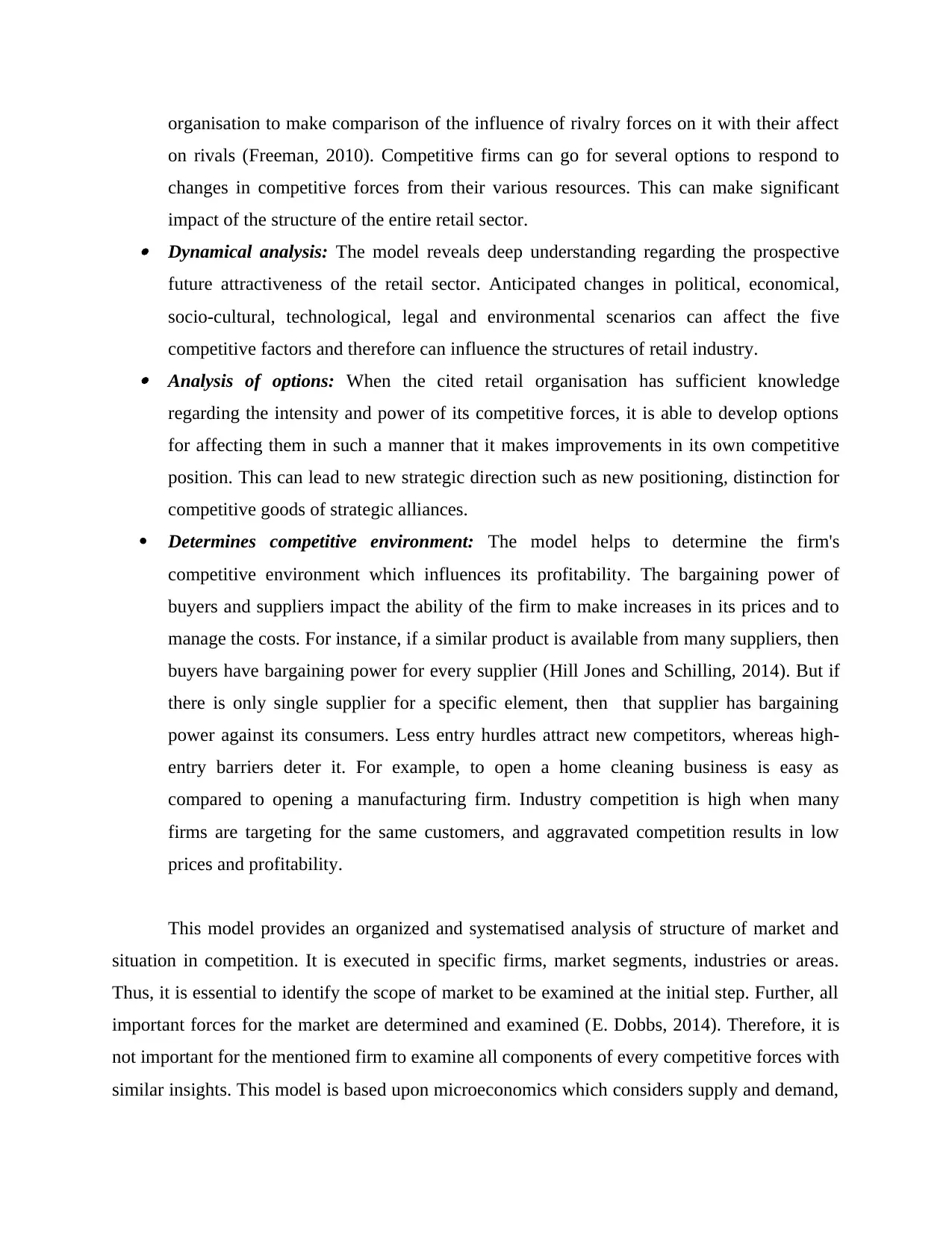
organisation to make comparison of the influence of rivalry forces on it with their affect
on rivals (Freeman, 2010). Competitive firms can go for several options to respond to
changes in competitive forces from their various resources. This can make significant
impact of the structure of the entire retail sector. Dynamical analysis: The model reveals deep understanding regarding the prospective
future attractiveness of the retail sector. Anticipated changes in political, economical,
socio-cultural, technological, legal and environmental scenarios can affect the five
competitive factors and therefore can influence the structures of retail industry. Analysis of options: When the cited retail organisation has sufficient knowledge
regarding the intensity and power of its competitive forces, it is able to develop options
for affecting them in such a manner that it makes improvements in its own competitive
position. This can lead to new strategic direction such as new positioning, distinction for
competitive goods of strategic alliances.
Determines competitive environment: The model helps to determine the firm's
competitive environment which influences its profitability. The bargaining power of
buyers and suppliers impact the ability of the firm to make increases in its prices and to
manage the costs. For instance, if a similar product is available from many suppliers, then
buyers have bargaining power for every supplier (Hill Jones and Schilling, 2014). But if
there is only single supplier for a specific element, then that supplier has bargaining
power against its consumers. Less entry hurdles attract new competitors, whereas high-
entry barriers deter it. For example, to open a home cleaning business is easy as
compared to opening a manufacturing firm. Industry competition is high when many
firms are targeting for the same customers, and aggravated competition results in low
prices and profitability.
This model provides an organized and systematised analysis of structure of market and
situation in competition. It is executed in specific firms, market segments, industries or areas.
Thus, it is essential to identify the scope of market to be examined at the initial step. Further, all
important forces for the market are determined and examined (E. Dobbs, 2014). Therefore, it is
not important for the mentioned firm to examine all components of every competitive forces with
similar insights. This model is based upon microeconomics which considers supply and demand,
on rivals (Freeman, 2010). Competitive firms can go for several options to respond to
changes in competitive forces from their various resources. This can make significant
impact of the structure of the entire retail sector. Dynamical analysis: The model reveals deep understanding regarding the prospective
future attractiveness of the retail sector. Anticipated changes in political, economical,
socio-cultural, technological, legal and environmental scenarios can affect the five
competitive factors and therefore can influence the structures of retail industry. Analysis of options: When the cited retail organisation has sufficient knowledge
regarding the intensity and power of its competitive forces, it is able to develop options
for affecting them in such a manner that it makes improvements in its own competitive
position. This can lead to new strategic direction such as new positioning, distinction for
competitive goods of strategic alliances.
Determines competitive environment: The model helps to determine the firm's
competitive environment which influences its profitability. The bargaining power of
buyers and suppliers impact the ability of the firm to make increases in its prices and to
manage the costs. For instance, if a similar product is available from many suppliers, then
buyers have bargaining power for every supplier (Hill Jones and Schilling, 2014). But if
there is only single supplier for a specific element, then that supplier has bargaining
power against its consumers. Less entry hurdles attract new competitors, whereas high-
entry barriers deter it. For example, to open a home cleaning business is easy as
compared to opening a manufacturing firm. Industry competition is high when many
firms are targeting for the same customers, and aggravated competition results in low
prices and profitability.
This model provides an organized and systematised analysis of structure of market and
situation in competition. It is executed in specific firms, market segments, industries or areas.
Thus, it is essential to identify the scope of market to be examined at the initial step. Further, all
important forces for the market are determined and examined (E. Dobbs, 2014). Therefore, it is
not important for the mentioned firm to examine all components of every competitive forces with
similar insights. This model is based upon microeconomics which considers supply and demand,
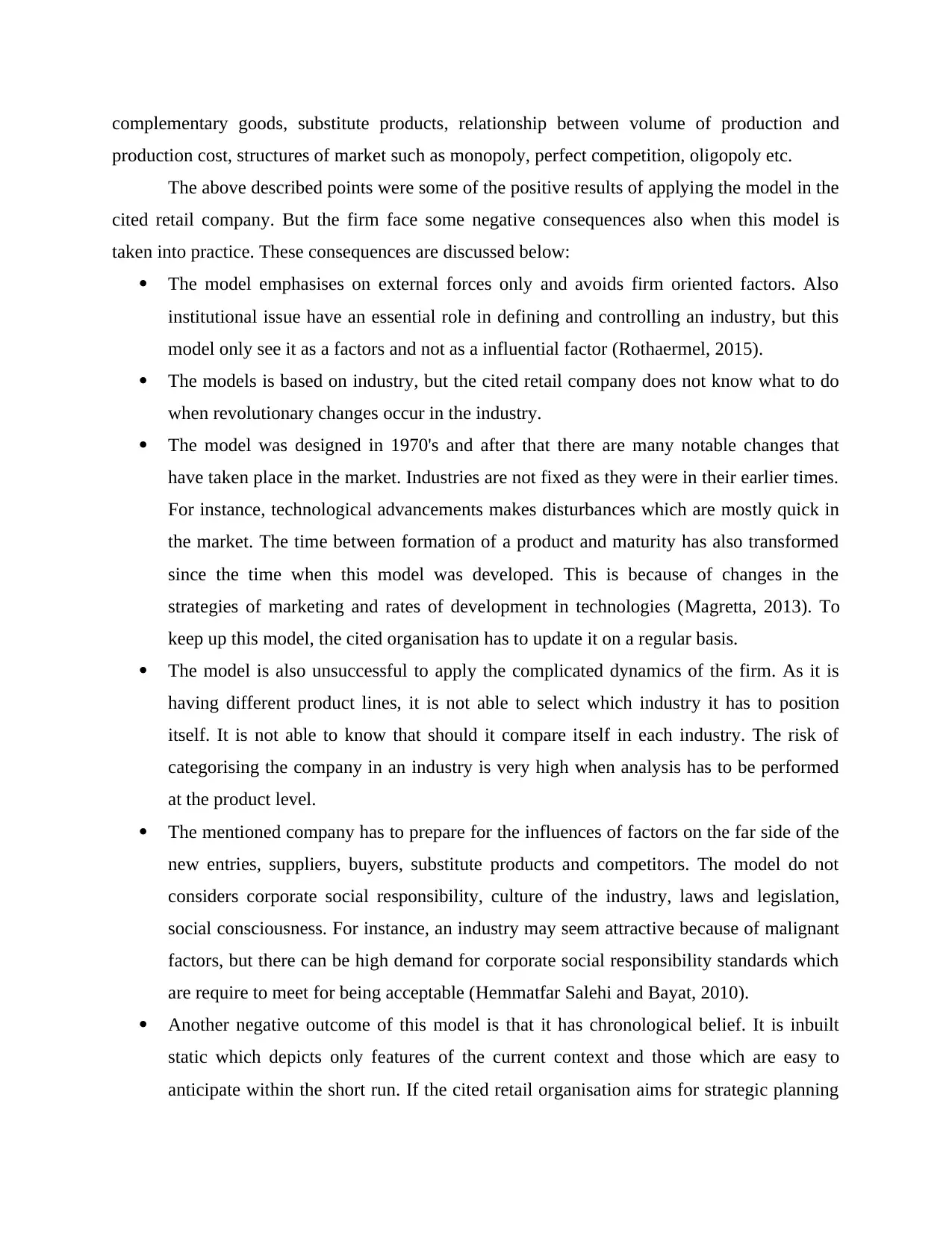
complementary goods, substitute products, relationship between volume of production and
production cost, structures of market such as monopoly, perfect competition, oligopoly etc.
The above described points were some of the positive results of applying the model in the
cited retail company. But the firm face some negative consequences also when this model is
taken into practice. These consequences are discussed below:
The model emphasises on external forces only and avoids firm oriented factors. Also
institutional issue have an essential role in defining and controlling an industry, but this
model only see it as a factors and not as a influential factor (Rothaermel, 2015).
The models is based on industry, but the cited retail company does not know what to do
when revolutionary changes occur in the industry.
The model was designed in 1970's and after that there are many notable changes that
have taken place in the market. Industries are not fixed as they were in their earlier times.
For instance, technological advancements makes disturbances which are mostly quick in
the market. The time between formation of a product and maturity has also transformed
since the time when this model was developed. This is because of changes in the
strategies of marketing and rates of development in technologies (Magretta, 2013). To
keep up this model, the cited organisation has to update it on a regular basis.
The model is also unsuccessful to apply the complicated dynamics of the firm. As it is
having different product lines, it is not able to select which industry it has to position
itself. It is not able to know that should it compare itself in each industry. The risk of
categorising the company in an industry is very high when analysis has to be performed
at the product level.
The mentioned company has to prepare for the influences of factors on the far side of the
new entries, suppliers, buyers, substitute products and competitors. The model do not
considers corporate social responsibility, culture of the industry, laws and legislation,
social consciousness. For instance, an industry may seem attractive because of malignant
factors, but there can be high demand for corporate social responsibility standards which
are require to meet for being acceptable (Hemmatfar Salehi and Bayat, 2010).
Another negative outcome of this model is that it has chronological belief. It is inbuilt
static which depicts only features of the current context and those which are easy to
anticipate within the short run. If the cited retail organisation aims for strategic planning
production cost, structures of market such as monopoly, perfect competition, oligopoly etc.
The above described points were some of the positive results of applying the model in the
cited retail company. But the firm face some negative consequences also when this model is
taken into practice. These consequences are discussed below:
The model emphasises on external forces only and avoids firm oriented factors. Also
institutional issue have an essential role in defining and controlling an industry, but this
model only see it as a factors and not as a influential factor (Rothaermel, 2015).
The models is based on industry, but the cited retail company does not know what to do
when revolutionary changes occur in the industry.
The model was designed in 1970's and after that there are many notable changes that
have taken place in the market. Industries are not fixed as they were in their earlier times.
For instance, technological advancements makes disturbances which are mostly quick in
the market. The time between formation of a product and maturity has also transformed
since the time when this model was developed. This is because of changes in the
strategies of marketing and rates of development in technologies (Magretta, 2013). To
keep up this model, the cited organisation has to update it on a regular basis.
The model is also unsuccessful to apply the complicated dynamics of the firm. As it is
having different product lines, it is not able to select which industry it has to position
itself. It is not able to know that should it compare itself in each industry. The risk of
categorising the company in an industry is very high when analysis has to be performed
at the product level.
The mentioned company has to prepare for the influences of factors on the far side of the
new entries, suppliers, buyers, substitute products and competitors. The model do not
considers corporate social responsibility, culture of the industry, laws and legislation,
social consciousness. For instance, an industry may seem attractive because of malignant
factors, but there can be high demand for corporate social responsibility standards which
are require to meet for being acceptable (Hemmatfar Salehi and Bayat, 2010).
Another negative outcome of this model is that it has chronological belief. It is inbuilt
static which depicts only features of the current context and those which are easy to
anticipate within the short run. If the cited retail organisation aims for strategic planning
⊘ This is a preview!⊘
Do you want full access?
Subscribe today to unlock all pages.

Trusted by 1+ million students worldwide
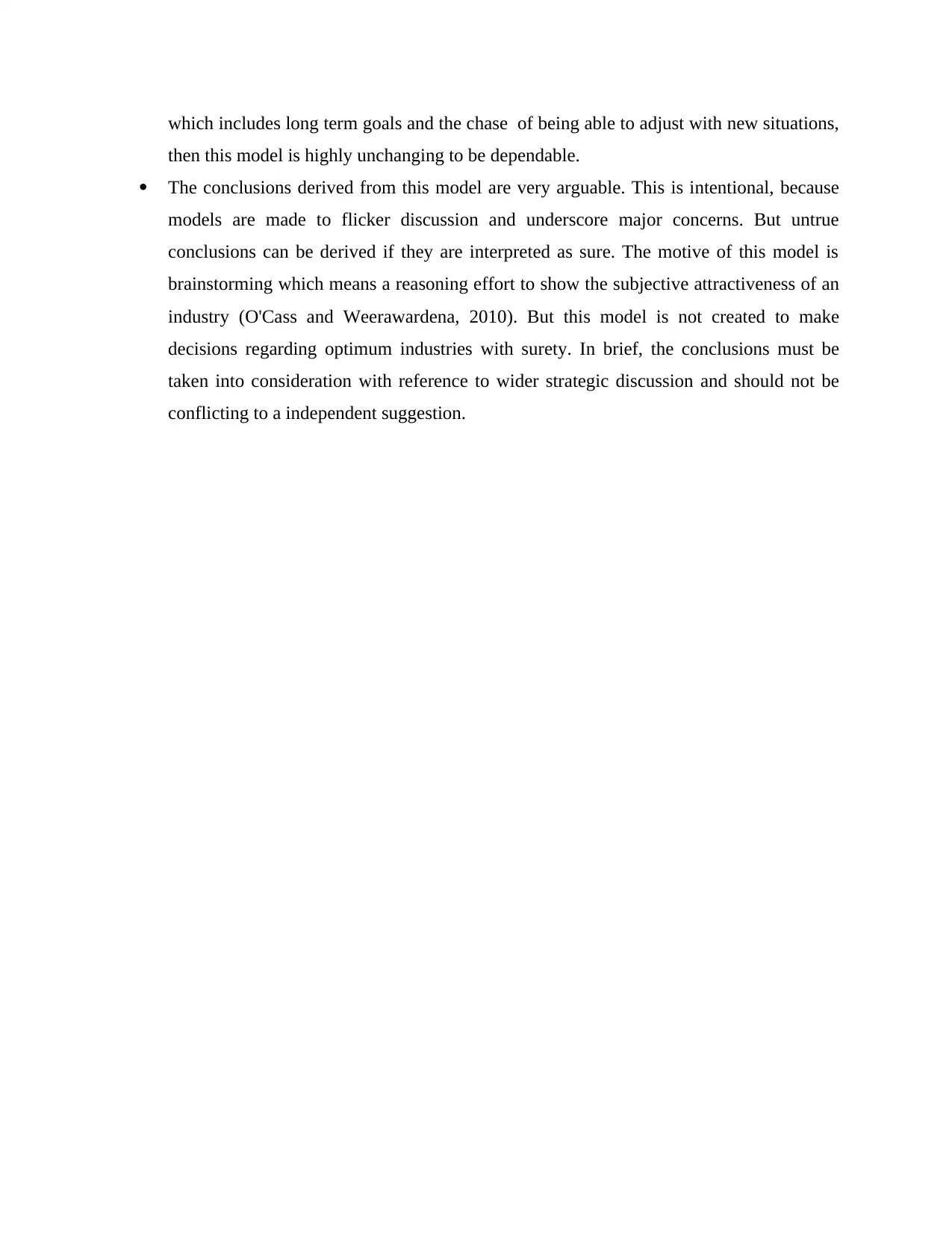
which includes long term goals and the chase of being able to adjust with new situations,
then this model is highly unchanging to be dependable.
The conclusions derived from this model are very arguable. This is intentional, because
models are made to flicker discussion and underscore major concerns. But untrue
conclusions can be derived if they are interpreted as sure. The motive of this model is
brainstorming which means a reasoning effort to show the subjective attractiveness of an
industry (O'Cass and Weerawardena, 2010). But this model is not created to make
decisions regarding optimum industries with surety. In brief, the conclusions must be
taken into consideration with reference to wider strategic discussion and should not be
conflicting to a independent suggestion.
then this model is highly unchanging to be dependable.
The conclusions derived from this model are very arguable. This is intentional, because
models are made to flicker discussion and underscore major concerns. But untrue
conclusions can be derived if they are interpreted as sure. The motive of this model is
brainstorming which means a reasoning effort to show the subjective attractiveness of an
industry (O'Cass and Weerawardena, 2010). But this model is not created to make
decisions regarding optimum industries with surety. In brief, the conclusions must be
taken into consideration with reference to wider strategic discussion and should not be
conflicting to a independent suggestion.
Paraphrase This Document
Need a fresh take? Get an instant paraphrase of this document with our AI Paraphraser
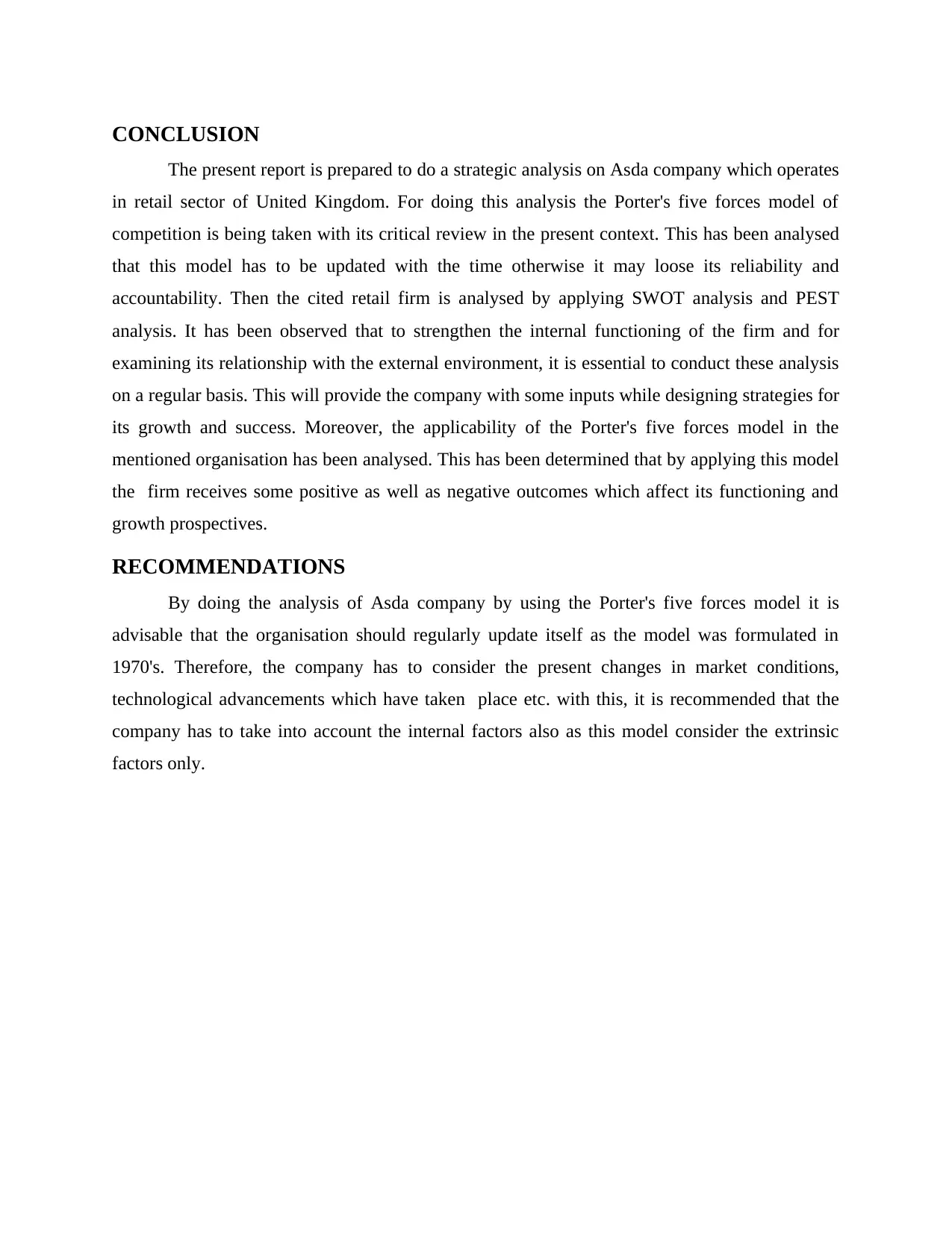
CONCLUSION
The present report is prepared to do a strategic analysis on Asda company which operates
in retail sector of United Kingdom. For doing this analysis the Porter's five forces model of
competition is being taken with its critical review in the present context. This has been analysed
that this model has to be updated with the time otherwise it may loose its reliability and
accountability. Then the cited retail firm is analysed by applying SWOT analysis and PEST
analysis. It has been observed that to strengthen the internal functioning of the firm and for
examining its relationship with the external environment, it is essential to conduct these analysis
on a regular basis. This will provide the company with some inputs while designing strategies for
its growth and success. Moreover, the applicability of the Porter's five forces model in the
mentioned organisation has been analysed. This has been determined that by applying this model
the firm receives some positive as well as negative outcomes which affect its functioning and
growth prospectives.
RECOMMENDATIONS
By doing the analysis of Asda company by using the Porter's five forces model it is
advisable that the organisation should regularly update itself as the model was formulated in
1970's. Therefore, the company has to consider the present changes in market conditions,
technological advancements which have taken place etc. with this, it is recommended that the
company has to take into account the internal factors also as this model consider the extrinsic
factors only.
The present report is prepared to do a strategic analysis on Asda company which operates
in retail sector of United Kingdom. For doing this analysis the Porter's five forces model of
competition is being taken with its critical review in the present context. This has been analysed
that this model has to be updated with the time otherwise it may loose its reliability and
accountability. Then the cited retail firm is analysed by applying SWOT analysis and PEST
analysis. It has been observed that to strengthen the internal functioning of the firm and for
examining its relationship with the external environment, it is essential to conduct these analysis
on a regular basis. This will provide the company with some inputs while designing strategies for
its growth and success. Moreover, the applicability of the Porter's five forces model in the
mentioned organisation has been analysed. This has been determined that by applying this model
the firm receives some positive as well as negative outcomes which affect its functioning and
growth prospectives.
RECOMMENDATIONS
By doing the analysis of Asda company by using the Porter's five forces model it is
advisable that the organisation should regularly update itself as the model was formulated in
1970's. Therefore, the company has to consider the present changes in market conditions,
technological advancements which have taken place etc. with this, it is recommended that the
company has to take into account the internal factors also as this model consider the extrinsic
factors only.
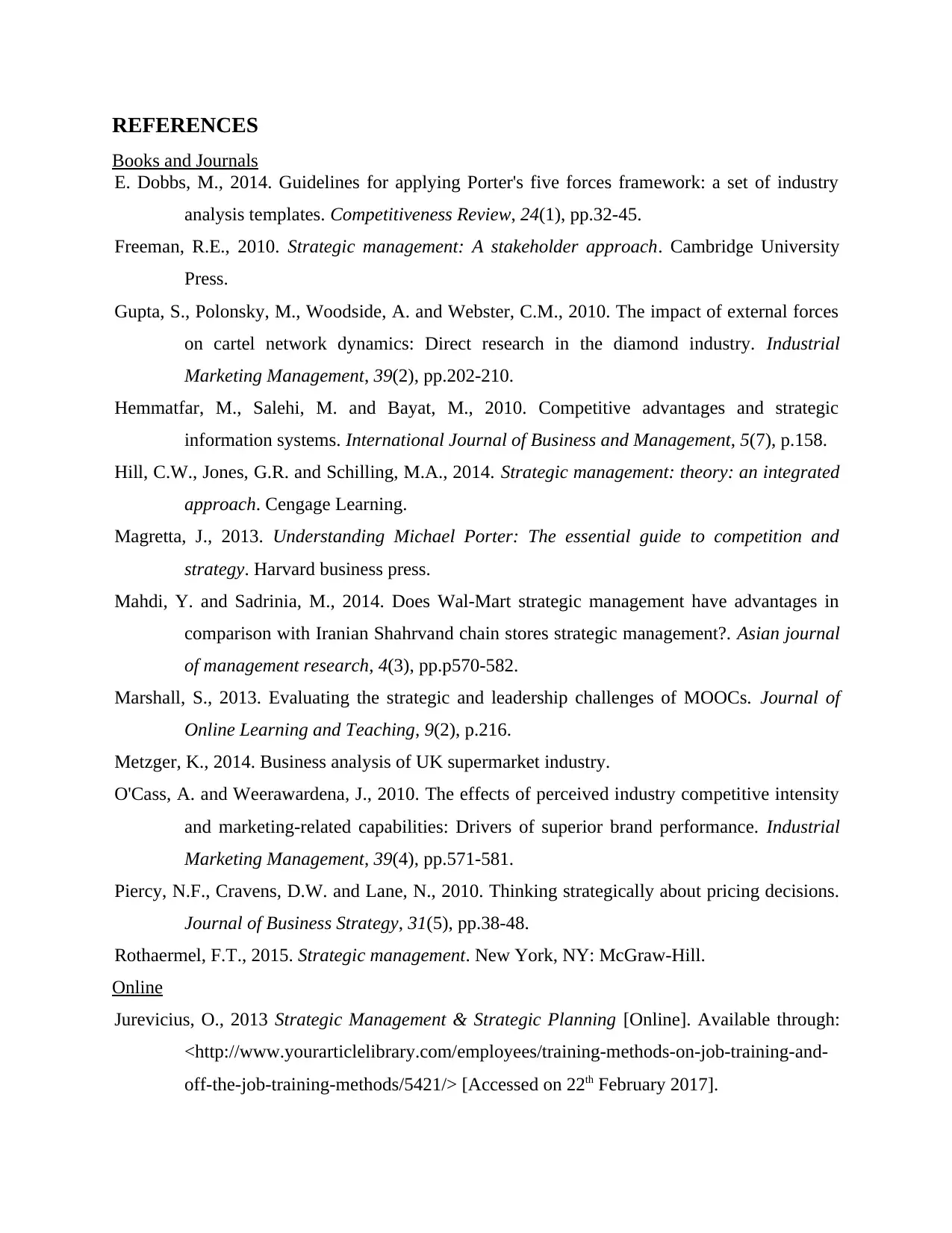
REFERENCES
Books and Journals
E. Dobbs, M., 2014. Guidelines for applying Porter's five forces framework: a set of industry
analysis templates. Competitiveness Review, 24(1), pp.32-45.
Freeman, R.E., 2010. Strategic management: A stakeholder approach. Cambridge University
Press.
Gupta, S., Polonsky, M., Woodside, A. and Webster, C.M., 2010. The impact of external forces
on cartel network dynamics: Direct research in the diamond industry. Industrial
Marketing Management, 39(2), pp.202-210.
Hemmatfar, M., Salehi, M. and Bayat, M., 2010. Competitive advantages and strategic
information systems. International Journal of Business and Management, 5(7), p.158.
Hill, C.W., Jones, G.R. and Schilling, M.A., 2014. Strategic management: theory: an integrated
approach. Cengage Learning.
Magretta, J., 2013. Understanding Michael Porter: The essential guide to competition and
strategy. Harvard business press.
Mahdi, Y. and Sadrinia, M., 2014. Does Wal-Mart strategic management have advantages in
comparison with Iranian Shahrvand chain stores strategic management?. Asian journal
of management research, 4(3), pp.p570-582.
Marshall, S., 2013. Evaluating the strategic and leadership challenges of MOOCs. Journal of
Online Learning and Teaching, 9(2), p.216.
Metzger, K., 2014. Business analysis of UK supermarket industry.
O'Cass, A. and Weerawardena, J., 2010. The effects of perceived industry competitive intensity
and marketing-related capabilities: Drivers of superior brand performance. Industrial
Marketing Management, 39(4), pp.571-581.
Piercy, N.F., Cravens, D.W. and Lane, N., 2010. Thinking strategically about pricing decisions.
Journal of Business Strategy, 31(5), pp.38-48.
Rothaermel, F.T., 2015. Strategic management. New York, NY: McGraw-Hill.
Online
Jurevicius, O., 2013 Strategic Management & Strategic Planning [Online]. Available through:
<http://www.yourarticlelibrary.com/employees/training-methods-on-job-training-and-
off-the-job-training-methods/5421/> [Accessed on 22th February 2017].
Books and Journals
E. Dobbs, M., 2014. Guidelines for applying Porter's five forces framework: a set of industry
analysis templates. Competitiveness Review, 24(1), pp.32-45.
Freeman, R.E., 2010. Strategic management: A stakeholder approach. Cambridge University
Press.
Gupta, S., Polonsky, M., Woodside, A. and Webster, C.M., 2010. The impact of external forces
on cartel network dynamics: Direct research in the diamond industry. Industrial
Marketing Management, 39(2), pp.202-210.
Hemmatfar, M., Salehi, M. and Bayat, M., 2010. Competitive advantages and strategic
information systems. International Journal of Business and Management, 5(7), p.158.
Hill, C.W., Jones, G.R. and Schilling, M.A., 2014. Strategic management: theory: an integrated
approach. Cengage Learning.
Magretta, J., 2013. Understanding Michael Porter: The essential guide to competition and
strategy. Harvard business press.
Mahdi, Y. and Sadrinia, M., 2014. Does Wal-Mart strategic management have advantages in
comparison with Iranian Shahrvand chain stores strategic management?. Asian journal
of management research, 4(3), pp.p570-582.
Marshall, S., 2013. Evaluating the strategic and leadership challenges of MOOCs. Journal of
Online Learning and Teaching, 9(2), p.216.
Metzger, K., 2014. Business analysis of UK supermarket industry.
O'Cass, A. and Weerawardena, J., 2010. The effects of perceived industry competitive intensity
and marketing-related capabilities: Drivers of superior brand performance. Industrial
Marketing Management, 39(4), pp.571-581.
Piercy, N.F., Cravens, D.W. and Lane, N., 2010. Thinking strategically about pricing decisions.
Journal of Business Strategy, 31(5), pp.38-48.
Rothaermel, F.T., 2015. Strategic management. New York, NY: McGraw-Hill.
Online
Jurevicius, O., 2013 Strategic Management & Strategic Planning [Online]. Available through:
<http://www.yourarticlelibrary.com/employees/training-methods-on-job-training-and-
off-the-job-training-methods/5421/> [Accessed on 22th February 2017].
⊘ This is a preview!⊘
Do you want full access?
Subscribe today to unlock all pages.

Trusted by 1+ million students worldwide
1 out of 13
Related Documents
Your All-in-One AI-Powered Toolkit for Academic Success.
+13062052269
info@desklib.com
Available 24*7 on WhatsApp / Email
![[object Object]](/_next/static/media/star-bottom.7253800d.svg)
Unlock your academic potential
Copyright © 2020–2025 A2Z Services. All Rights Reserved. Developed and managed by ZUCOL.





